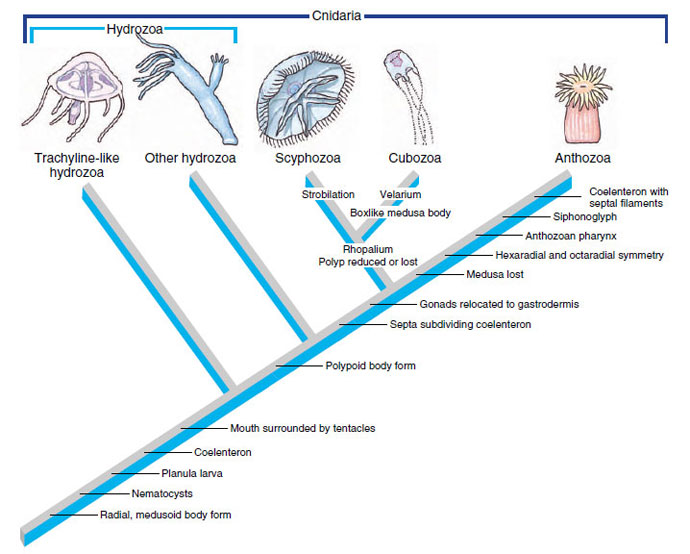Phylogeny and Adaptive Radiation
Phylogeny and
Adaptive Radiation
Phylogeny
The origin of the cnidarians and ctenophores is obscure, although the most widely supported hypothesis today is that the radiate phyla arose from a radially symmetrical, planulalike ancestor. Such an ancestor could have been common to the radiates and to the higher metazoans, the latter having been derived from a branch whose members habitually crept about on the sea bottom. Such a habit would select for bilateral symmetry. Others became sessile or free floating, conditions for which radial symmetry is a selective advantage. A planula larva in which an invagination formed to become the gastrovascular cavity would correspond roughly to a cnidarian with an ectoderm and an endoderm.
Some researchers believe trachyline medusae (an order of class Hydrozoa) resemble the ancestral cnidarian because of their direct development from planula and actinula larvae to medusas (Figure 13-38). The trachylinelike ancestor would have given rise to other cnidarian lines after the evolution of the polyp stage and alternation of sexual (medusa) and asexual (polyp) generations. Subsequently, the medusa was completely lost in the anthozoan line. If the order Trachylina is retained within class Hydrozoa, however, then Hydrozoa becomes paraphyletic. Future investigators may resolve this problem.
Ctenophores formerly were thought to have arisen from a medusoid cnidarian, but this hypothesis has been challenged. Similarities between the groups are mostly of a general nature and do not seem to indicate a close relationship. Molecular evidence suggests that ctenophores branched from the metazoan line after sponges but before cnidarians and placozoans.
Adaptive Radiation
In their evolution neither phylum has deviated far from its basic plan of structure. In Cnidaria, both polyp and medusa are constructed on the same scheme. Likewise, ctenophores have adhered to the arrangement of the comb plates and their biradial symmetry.
Nonetheless, cnidarians have achieved large numbers of individuals and species, demonstrating a surprising degree of diversity considering the simplicity of their basic body plan. They are efficient predators, many feeding on prey quite large in relation to themselves. Some are adapted for feeding on small particles. The colonial form of life is well explored, with some colonies growing to great size among corals, and others, such as siphonophores, showing astonishing polymorphism and specialization of individuals within a colony.
Phylogeny
The origin of the cnidarians and ctenophores is obscure, although the most widely supported hypothesis today is that the radiate phyla arose from a radially symmetrical, planulalike ancestor. Such an ancestor could have been common to the radiates and to the higher metazoans, the latter having been derived from a branch whose members habitually crept about on the sea bottom. Such a habit would select for bilateral symmetry. Others became sessile or free floating, conditions for which radial symmetry is a selective advantage. A planula larva in which an invagination formed to become the gastrovascular cavity would correspond roughly to a cnidarian with an ectoderm and an endoderm.
Some researchers believe trachyline medusae (an order of class Hydrozoa) resemble the ancestral cnidarian because of their direct development from planula and actinula larvae to medusas (Figure 13-38). The trachylinelike ancestor would have given rise to other cnidarian lines after the evolution of the polyp stage and alternation of sexual (medusa) and asexual (polyp) generations. Subsequently, the medusa was completely lost in the anthozoan line. If the order Trachylina is retained within class Hydrozoa, however, then Hydrozoa becomes paraphyletic. Future investigators may resolve this problem.
 |
| Figure 13-38 Cladogram showing hypothetical relationships of cnidarian classes with some shared derived characters indicated. This hypothesis suggests that the hydrozoan order Trachylina retains the ancestral cnidarian life cycle, having branched off before the evolution of the polyp stage. Note that this arrangement makes the Hydrozoa paraphyletic; the trachyline-like Hydrozoa is the sister group to all the other Cnidaria. |
Ctenophores formerly were thought to have arisen from a medusoid cnidarian, but this hypothesis has been challenged. Similarities between the groups are mostly of a general nature and do not seem to indicate a close relationship. Molecular evidence suggests that ctenophores branched from the metazoan line after sponges but before cnidarians and placozoans.
Adaptive Radiation
In their evolution neither phylum has deviated far from its basic plan of structure. In Cnidaria, both polyp and medusa are constructed on the same scheme. Likewise, ctenophores have adhered to the arrangement of the comb plates and their biradial symmetry.
Nonetheless, cnidarians have achieved large numbers of individuals and species, demonstrating a surprising degree of diversity considering the simplicity of their basic body plan. They are efficient predators, many feeding on prey quite large in relation to themselves. Some are adapted for feeding on small particles. The colonial form of life is well explored, with some colonies growing to great size among corals, and others, such as siphonophores, showing astonishing polymorphism and specialization of individuals within a colony.




